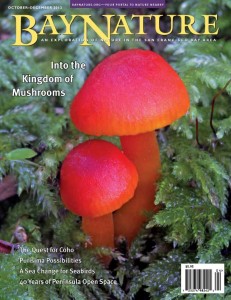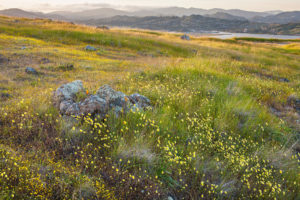Early in our work on each issue of the magazine, we send out a call for photos to more than 400 local photographers and artists. The idea is maybe they have some images on file that fit with stories we have in the next issue. It always feels a bit like a leap of faith. What are the chances that every time we’re going to get great images?
Well, we seem to have won the gamble again. Our cover photographer, Ron Wolf, sent a package of more than 100 mushroom photos, including the stunning jack-o-lantern mushrooms on our forthcoming October issue cover. (Out in a few weeks! Not a subscriber? Order by September 17 to get the October issue!)
The half dozen shots we used are just the tip of the iceberg for Wolf’s mushroom photos: “What I have posted on Flickr is 976 fungi photos. That’s what’s posted publicly,” he says. “In my database, I’ll probably five or six or seven times that. Multiple views and shots I haven’t processed and stuff like that.”

But Wolf’s not even a mushroom-specialist: “I fell into fungi through the backdoor. I am primarily a bird photographer, then a wildflower photographer. When I went out on my various forays, there were times when the birds weren’t cooperating, the wildflowers weren’t in bloom.”
So Wolf’s reason for photographing mushrooms is the same reason we think mushroom hunting is a great winter pursuit, even in places where it’s illegal to pick and even for those of us (myself included) who wouldn’t know a poisonous mushroom from a supermarket special.
“What do you do in the middle of winter in California?” Wolf asks. “All the migrant birds are gone except the usual shorebird suspects, and there are no wildflowers out there, so the populations of insects and other pollinators are down. But because of the winter rains in the Santa Cruz Mountains, we get an incredible array of fungi. It’s like the Garden of Eden here. The place just blooms with every kind of mushroom imaginable.”
How does he find so many picturesque fungi? A lot of it is simply being outdoors, year after year.
“I have been around in the woods longer than I care to admit, 55 years or so,” says Wolf, “and I have always been in touch with my inner eight year old. You know at eight the best thing was to get out of school and splash through creeks and find salamanders and climb trees and look into nests and things like that.”
So splashing around in creeks and on trails is how Wolf gets his shots, but he says that’s only half the work. The other half is documenting what the photos show and then keeping track of them. His careful records mean he can post clear IDs on his Flickr stream and also submit images to CalPhotos.berkeley.edu, where his photos led to connections with educators as far away as Turkey.

“There are a lot of people out there who are much much better photographers than I am,” he says, “but somehow or another people find their way to me. It doesn’t matter how good the photo is if someone can’t identify what it is.”
When it comes to cataloging photos, Wolf credits his career as a reporter and editor, including at the San Jose Mercury News: “I have spent a lot of years in a newsroom doing journalism, which is in a sense one big, long detective mystery. Life is a staggeringly large crossword puzzle in which you’re trying to fill in the blanks, which is not all that different from figuring out the taxonomy of species.”
And his favorite mushroom haunt? Portola Redwoods State Park.
“It’s the one that’s easy for me to pop over to from Palo Alto,” he explains, “but it’s on the road to nowhere, so you don’t take that road unless you’re going to Portola Redwoods. It’s also chronically on the governor’s hit list for closure because it doesn’t generate enough patronage to pay for itself, but it is one of those that gets an astonishing number of species from about mid-December on through the end of March. Great stuff all over the place and if one is an aficionado of fungi, it seems to me that this ought to be a global heritage site.“
Our cover story is actually focused on the mushrooms of the East Bay Regional Parks, but wherever you hike this winter, keep an eye out for the otherworldly colors and shapes of our local mushrooms. And don’t forget your camera.




-300x199.jpg)
